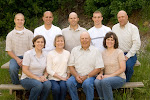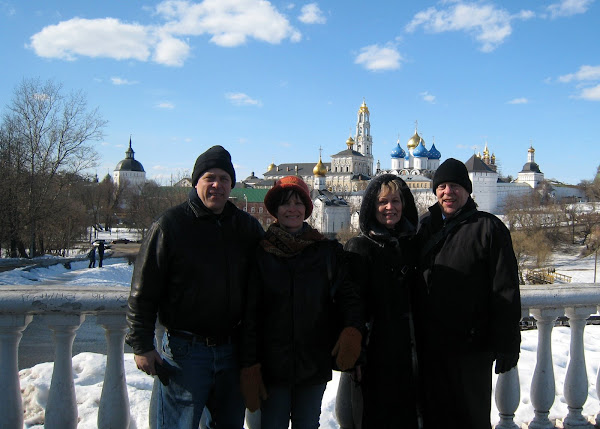As Senior Missionary Couples, we have probably seen more parks, museums, and places of interest in Moscow than many Russians, which is quite often the case when someone is a short time in a country and wants to experience as much as possible before leaving. We do appreciate those Saturdays when we get together to experience this culture and learn more about Moscow and Russia.
Saturday, October 5, we visited two house museums of Russian authors with the Masons, Shepards, and a friend of the Shepards. We first went to the Gorky Museum. The mansion was presented as a gift by Stalin in 1931 to Maxim Gorky, the famous socialist writer. Gorky lived from 1868 to 1936.
 The Gorky House Museum
The Gorky House MuseumThis was his home from 1931 until he died in 1936.
By the time Gorky moved to this house, his literary career was declining and he only wrote one play here. He became a propaganda tool for the Bolshevik Party because of his earlier support, and he served as president of the Union of Writers.
Spiral staircase of polished Estonian limestone
in the Gorky House Museum.
in the Gorky House Museum.
 The spiral staircase curves back around to
The spiral staircase curves back around toform a small bench at the bottom
where several couples had a picture taken
before we were told we were not to sit there.
(Narene & Sam)
 The house had stained-glass windows,
The house had stained-glass windows,carved door frames,
ceilings with elaborate moldings,
ceramic tiles, and wood inlaid floors.
 Gorky's collection of oriental carvings.
Gorky's collection of oriental carvings. Library in the Gorky Museum,
Library in the Gorky Museum,including some first editions.
One of his quotes: "When work is a pleasure,
life is a joy! When work is duty, life is slavery."
 We were getting hungry and couldn't find a place
We were getting hungry and couldn't find a placeto eat our lunch, so we decided this would do.
(Greg, Narene, Renee, & Chuck)
The man standing in the picture above is not part of our group. Unbeknown to me, he was trying to draw a picture of me while I was eating. When he handed me his finished drawing, it was backwards so all I saw was what looked like scribbling. After he walked away, I turned the paper around, and using my imagination I could kind of make out the outline of a person's head. It was like a child might draw a person's profile. Maybe he expected me to pay him for drawing "my picture," but he just handed it to me and left.
This turquoise blue mansion on
Arbat Street is the Pushkin Museum.
The next house museum we visited was the Pushkin Museum on Arbat Street where Alexander Pushkin and his 18-year-old bride, Natalya Goncharova, lived for only three months in 1831 before moving to St. Petersburg. In 1837, at the age of 37, he was fatally wounded in a dual with his brother-in-law following rumors that he was having an affair with Natalya.Arbat Street is the Pushkin Museum.
To tour the house, each person had to put on
these big shoe protectors.
 There were pretty inlaid-wood floors to protect.
There were pretty inlaid-wood floors to protect.
these big shoe protectors.
 There were pretty inlaid-wood floors to protect.
There were pretty inlaid-wood floors to protect.This museum features portraits, sketches, some original manuscripts and other memorabilia; but most of it is in Russian. It does not seem like a home, because there was very little furnishings or personal objects. The fact that Pushkin and his wife lived there for only three months also made it seem less like it was their home. I did read that Tchaikovsky lived there for a short time in 1875.
 Monument of Alexander Pushkin
Monument of Alexander Pushkinand Natalya
Pushkin was 15 when he published his first poem and is considered to be the greatest Russian poet and the founder of modern Russian literature. Quoting Wikipedia: "Pushkin pioneered the use of vernacular speech in his poems and plays, creating a style of storytelling - mixing drama, romance, and satire - associated with Russian literature ever since and greatly influencing later Russian writers."
Pushkin is loved by the Russians, and there are many things in Moscow named after him - a street, a square, an embankment, a museum, a theater, a Metro station, and a library are some of them. I have an illustrated book of "Pushkin's Fairy Tales."
Leaving the Pushkin Museum, we continued walking leisurely on Arbat Street. It was a nice day for walking, and many people were doing the same thing. We didn't know what the occasion was, but we noticed a crowd and heard someone speaking over a microphone. It turned out to be dancers performing, and we stopped to watch and take some pictures.
Pushkin is loved by the Russians, and there are many things in Moscow named after him - a street, a square, an embankment, a museum, a theater, a Metro station, and a library are some of them. I have an illustrated book of "Pushkin's Fairy Tales."
Dancers performing on Arbat Street.
Leaving the Pushkin Museum, we continued walking leisurely on Arbat Street. It was a nice day for walking, and many people were doing the same thing. We didn't know what the occasion was, but we noticed a crowd and heard someone speaking over a microphone. It turned out to be dancers performing, and we stopped to watch and take some pictures.
 More of the dancers in costume.
More of the dancers in costume.We walked on and saw lots of other activity on Arbat Street - musicians, vendors, artists painting portraits, and souvenir shops. We stopped to talk to an American woman who had come to adopt the brother of her adopted little girl from eastern Russia.
A man and woman hoping passers by would
leave them some money for their
music and dancing.
leave them some money for their
music and dancing.
 A street vendor painting dolls and hoping for sales.
A street vendor painting dolls and hoping for sales. Checking out a hotel near Red Square where the
Checking out a hotel near Red Square where theMission Presidents might stay in February,
as Greg has the responsibility for making
the reservations.
 The park by Red Square.
The park by Red Square.Autumn colors with the lighting of the late afternoon
make for an unusual photo.
As we headed for home, we thought about our enjoyable day. Once again, we had walked quite a few miles while experiencing more of the Russian culture.












No comments:
Post a Comment